How to Get Visa as an Engineer in Japan – 2023 Guide

Getting a Japanese engineer work visa is the first step to working as a software engineer in Japan.
Well, nothing is different here, as a work visa is the first step to working in any foreign country.
However, one different thing is that, on the one hand, working as a software engineer in Japan has many advantages from career growth and stability perspectives; getting a working visa as a software engineer in Japan is much simpler than in many other countries.
This guide will cover various options for getting a Japan visa as a software engineer, including the HSP visa.
I will cover the eligibility requirements, required documentation, and detailed process flows for the application and timelines. Additionally, I will cover other aspects, e.g., dependent visas and the comparison of visa types for engineers.
Moreover, we will also provide the templates for various documents that you or your visa-sponsoring company in Japan must submit to immigration for the Japan engineer visa.
The Focus of this Engineer Visa Guide
However, in this guide, we will focus mainly on getting a visa as an engineer for a “salaried job” in Japan for foreigners. Therefore, this article will not cover the categories applicable to an engineer who wishes to run their own business on a “Business Visa” or want to prepare for launching a startup in Japan on a Japanese startup visa.
Please note that the Japanese Engineer/Specialist in Humanities/International Services visa category applies to software engineers and all other engineering fields.
Engineering Visa in Japan
The Engineering visa, for tech professionals, including software engineers, is the most common visa for a salaried job for foreigners in Japan.
With a validity of 1 year, 3 years, or 5 years, this visa falls under the Engineer/Specialist in Humanities/International Services category. It’s a vast category; apart from engineers, it covers various other professions.
However, some professions are exceptions, such as artists, entertainers, professors, etc. For these specific professions, Japan offers visas specifically meant for these professions, such as the artist visa.
Other types of Engineer Visas in Japan
HSP Visa
The HSP visa is another category for working as an engineer in Japan. HSP stands for “Highly Skilled Professional.”
This article will also cover the process and required documentation for a Japanese HSP visa application. However, please note that the HSP category applies to other professions besides engineering. We will cover all these categories in the infographic at the end of this guide.
Intra-Company Transfer Visa
If you work as an engineer in another country and your company transfers you to Japan for a fixed duration, you can go for the intra-company transferee category. However, the intra-company transfer visa is not in the scope of this article.
Criteria to Evaluate the Eligibility
The main requirements to be eligible for the Japanese engineering visa are as follows:
- Educational Qualification
- Related work experience
- Salary offered
- Status of the employer’s company & business
- Duration of the employment contract
A. Requirements for Educational Qualification
The ideal minimum qualification is, of course, a bachelor’s degree in the relevant technical field. Obviously, anything more than a bachelor’s degree will make visa approval much easier. However, Japanese immigration will ignore this requirement if you can show 10 or more years of related work experience.
But, in the absence of either of the above, you will be eligible for the engineering visa if you have cleared any of the information technology exams offered by other Asian countries, which the Japanese government approves. This is explained in the following sections.
What if you do not have a related degree or 10 years of related experience?
There are ways to qualify for a working visa as an engineer in Japan without a relevant educational degree or experience. For example, if you do not have a relevant university degree or 10 or more years of experience, the following alternative certifications will also make you eligible for the engineer visa:
1. Relevant Japanese vocational degrees or certifications
Without a relevant college degree, a certification from a Japanese specialized training school or vocational degree in the related field fulfills the qualification eligibility criteria for a visa to work as an engineer in Japan.
Some of such top vocational training institutes in Japan are as follows:
- Tokyo Metropolitan College of Industrial Technology
- Tokyo Design Technology Center
- Hokkaido High-Technology College
- Yokohama System Engineering
- Fukuoka College of Design and Technology
- I.T. College Okinawa
You can also find an exhaustive list of Japanese vocational schools here.
2. Approved I.T. Certifications from Other Countries for Japanese Working Visa
Many Asian countries have treaties to recognize other Asian countries’ selected training programs. For instance, Japan approves technical certifications from the entities mentioned in the following section.
These entities conduct various information technology tests to certify you. A certification from these entities fulfills the qualification eligibility criteria for an engineering visa to work as a software engineer in Japan.
(Note: From the following, the Philippines can be a good option for any English-speaking foreigner from any country. This is because the exam is offered in English and is open to other foreign engineers)
Japan Approved I.T. Certifications for Engineer Visa in South Asia
- India: If you are from India, DOEACC (Department of Electronics Accreditation of Computer Courses) A level, B level, or C level from the National Institute of Electronics & Information Technology of India are the approved certifications by Japan. Thus, a holder of these certifications is eligible for an engineering visa in Japan.
- Bangladesh: ITEE (Information Technology Engineers Examination) of Bangladesh is the national-level I.T. Engineers Examination governed by IPA, Japan. Moreover, they offer 4 levels of I.T. Exams recognized by Japan.
Approved I.T. Certifications for Japanese Visa in Southeast Asia
- Philippines: The Philippines National I.T. Standards Foundations (PHILNITS) was formerly known as the Japanese I.T. Standards Exams of the Philippines.
PHILNITS has an I.T. Certification Program from I.T. standards adopted from Japan. This certification is supported by the Philippines Department of Trade & Industry (DTI) and Japan’s Ministry of Economy, Trade & Industry (METI).
Moreover, these exams are in English and have no age limit or educational qualification requirements. Indeed, passing these exams fulfills the engineering visa qualification requirements of Japan.
- Singapore: Technical courses from the Singapore Computer Society
- Malaysia: METEOR (Multimedia Technology Enhancement Operations Sdn. Bhd.) was formed by a consortium of eleven Malaysia public universities
- Myanmar: Myanmar Computer Federation offers various courses in the Information Technology area. Japan recognizes these courses and certifications and makes you eligible for a Japanese engineering visa.
- Thailand: NSTDA (National Science and Technology Development Agency)
- Vietnam: High-Tech Training and Incubation Center
Japan Approved I.T. Certifications for Japanese Visa in Far-East Asia
- Taiwan: The Institute of Information Industry of Taiwan, in addition to the internal staff training programs designed by the Human Resource Development Division, also provides professional training courses to the public. Founded in 1979, III’s Digital Education Institute (DEI) offers ICT-related certificate courses in Taiwan. The Japanese government approves these certifications as the eligibility criteria for ICT (Information and Communication Technology) jobs in Japan. Naturally, these certifications are also recognized as the eligibility criteria for the engineering visa.
- China: Relevant vocational exams from the Ministry of Industry & Information Technology are recognized by Japan for visa qualifications for software engineers.
- Korea: HRD Services, Korea, offers information technology training courses and tests accepted by Japanese immigration laws for Engineering visas.
- Mongolia: The National Information Technology Park (NITP) of Mongolia joined the Information Technology Professionals Examination Council (ITPEC) as a member in 2005. Subsequently, in 2006, they became the official Information Technology Engineers Examination (ITEE) organizer. Japan, which is a member of ITPEC, recognizes the certifications from NITP of Mongolia for the Japanese engineering visa.
Note: You can also qualify for the Japanese engineering visa based on the length of your experience in the absence of the above qualifications. However, you must have 10 or more years of technical experience relevant to your desired job.
B. Requirement for Minimum Salary
For your visa to be approved as an engineer, the salary offered to you should be at par with, or more, what a Japanese national would receive for the same job. Obviously, this is to prevent Japanese companies from going for cheaper technical talent from abroad at the cost of local talents’ jobs.
C. Business Stability of Your Employer
Japanese immigration would also like to ensure that the visa-sponsoring company can afford your salary for the entire duration of your employment.
Undoubtedly, this is for the safety of prospective employees. Therefore, they check various details about the company’s operation, history, and profit & loss statements. Also, if the company’s operation in Japan is less than one year old, immigration asks for a detailed business plan for the next year to approve the visa.
D. Requirement for Minimum Duration of the Employment
If it is a fixed-term contract job, the minimum duration of the employment must be at least one year for visa approval. Obviously, the logic behind this requirement is that the minimum work visa duration is one year in Japan.
Validity of the Engineering Visa
There are three options for the validity of the Engineering Visa
- 1-year
- 3-years
- 5-years
Naturally, your employer sponsoring your working visa in Japan can opt for any of the above validity options. However, the decision is always with the Japanese immigration authorities. For example, it’s always possible that the company opts for a 3-year or 5-year validity, but immigration issues a visa with a 1-year validity.
The company’s status is the primary factor Japanese immigration authorities consider to approve a longer-term validity. Therefore, it’s easier for a large and well-established company to get visas of longer durations.
Another factor is the employer’s history of sponsoring visas. Indeed, for a company with a long history of supporting multiple work visas in Japan, it’s easier to get longer-duration validity.
Just to let you know, renewing a visa is not challenging in Japan. If laws are not broken and paperwork is in order, work visa renewal in Japan is a piece of cake.
Process flow for the Engineering Visa: Infographic
In Japan, the process flow for every kind of long-term business-related visa is the same, and an engineering visa is no exception. For example, the process is as follows, which I have also shown visually in the infographic:
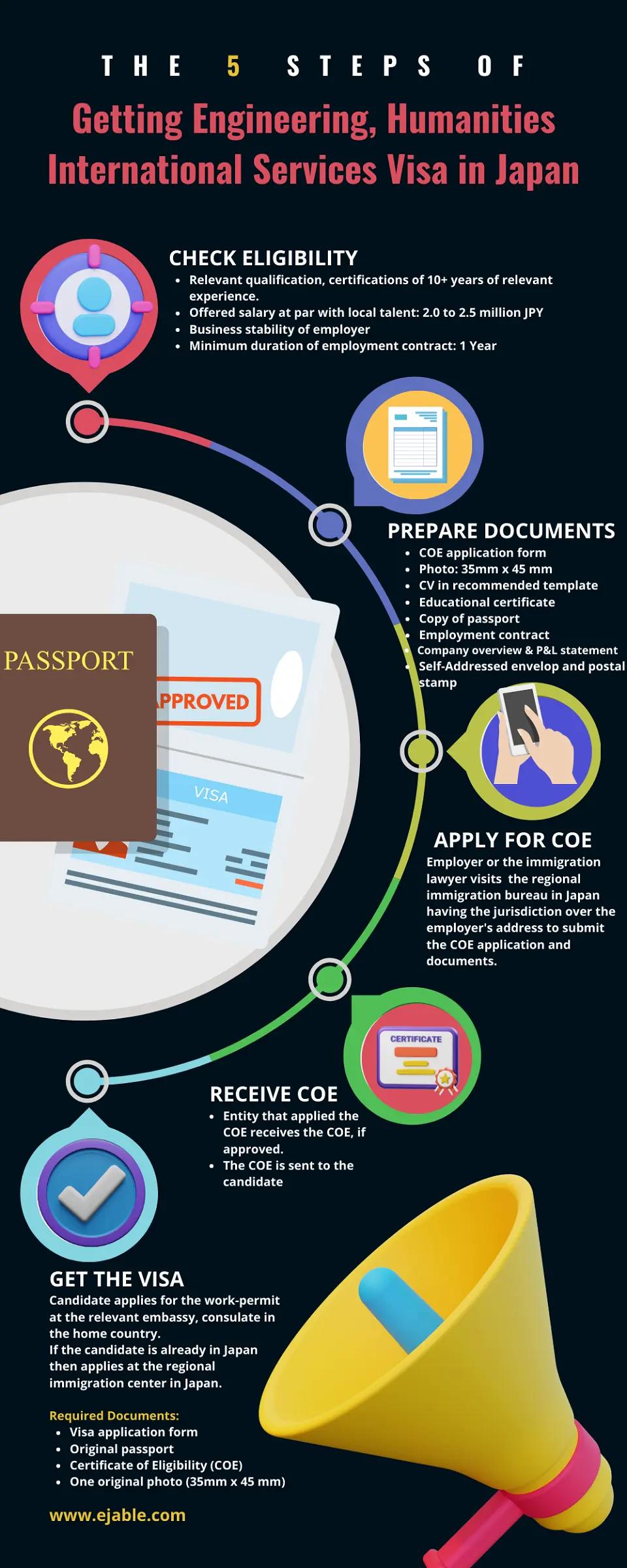

The process of getting an Engineering Work Permit in Japan
Step 1: Apply for the Certificate of Eligibility (COE)
The COE process is the exercise for the immigration authorities to check your application documents and credentials to decide if you are eligible for the visa type you have applied for. In this case, it’s an Engineering Visa.
Usually, the COE approval process takes 4 to 6 weeks.
However, it depends on the workload of the specific regional immigration office to which you apply for the visa.
For example, one of the slowest processes is generally at Tokyo’s Shinagawa immigration office.
The reason is simple: this particular immigration office has one of the highest workloads in Japan. Therefore, the approval can be much faster in other regional immigration offices. However, the immigration office must have jurisdiction over the applying entity’s address.
You can download the application form for COE here.
Application for the COE While in Japan Vs. While Outside
Suppose you are already in Japan on some other visa and applying for a status change by applying for the COE for the Engineer Visa. In that case, you can get the required documents from the employer and visit the Regional Immigration Services Bureau, which has jurisdiction over the address of your employer.
However, your employer sponsoring the visa typically takes care of this step directly or through an immigration lawyer.
On the other hand, if you are not in Japan, your employer must make arrangements for the COE application at the Immigration Service Bureau. Once the COE is received, your employer will send the COE to you so that you can apply for the visa in your home country.
Documents Required for the COE for Engineering Visa
| S. No. | Required Documents | Details | Documents Prepared by Employee | Documents Prepared by Employer |
|---|---|---|---|---|
| 1 | COE Application form | Information needed for the application form: 1. Marital status 2. Accompanying persons, if any 3. Past entries into Japan – How many times have you entered Japan – The latest entry to Japan from YYMMDD to YYMMDD 4. The existence of Family in Japan (Father, Mother, Spouse, Son, Daughter, Brother, Sister, or Others) | ✔ | ✔ |
| 2 | Photo | 1 photo (later on, you will need one more photo) 35mm x 45 mm (Black and White or Color, taken within the past 3 months) | ✔ | |
| 3 | Resume | One copy of the resume in the template shown below the table | ✔ | |
| 4 | University or College Graduation certificate (Diploma) | The original university diploma/degree certificate and one copy of the same. * If you have a master’s degree, please include that also. The original degree is to be shown to the immigration office and returned thereafter. (*Options available if there is no formal university degree are mentioned earlier in this article) | ✔ | |
| 5 | Copy of your Passport | Copy of the first two pages and the last page of your passport. (Pages with your photo, address, and family members’ names). | ✔ | |
| 6 | Employment Contract | With details about position, salary, and contract duration. | ✔ | |
| 7 | Company Overview | Detailing employer’s business area and a bit about the standing in the market. | ✔ | |
| 8 | P&L Statement of Employer | Please note that it’s easier for a profit-making company to get you the visa. | ✔ | |
| 9 | Company outline (in Japanese) | Similar to the company overview mentioned above but in Japanese. | ✔ | |
| 10 | Envelope with the company or immigration lawyer’s address | Immigration will use this envelope to send you the COE for the visa. | ✔ | |
| 11 | Postal stamp of JPY 404 | Please stick the postal stamp on the above-mentioned envelope. Please check the required stamp price at the time of visa application. | ✔ |
Resume Template for COE Application for the Engineering Visa
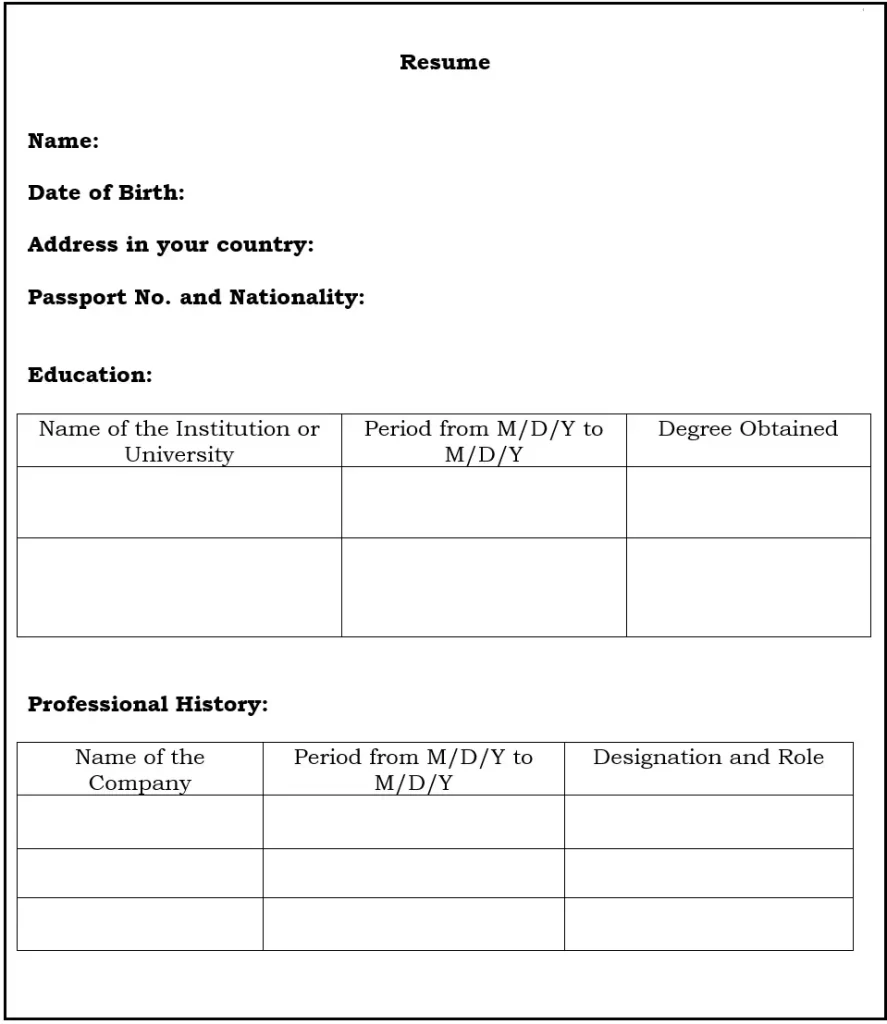

Step 2: Approval of your COE application
Once Japanese immigration authorities check all your documents and find you eligible to work as a software engineer in Japan, your COE for the Engineering Visa will be approved.
Subsequently, they will send the COE to the registered address. This address would be your employer’s office address as the visa sponsor. However, if the visa-sponsoring company has used an immigration lawyer to apply for the visa, then the COE will go to the office of the immigration lawyer.
The Certificate of Eligibility or COE certificate proves that immigration authorities have found you eligible to live and work in Japan. If you are currently in Japan with a soon-expiring visa in any other category, you can continue to stay in Japan based on the COE until your visa is processed.
COE Approval Process Timelines
The time for the COE approval process varies from city to city. Surely, the processing time depends on the workload of visa applications. However, 4 to 8 weeks is the average time for Japanese immigration to complete the COE approval process and inform you.
Please note that 8 weeks has become a norm if your application is at the “Tokyo Regional Immigration Bureau” at Shinagawa because of a very high workload. Just so you know, the Shinagawa center has jurisdiction over Tokyo, Saitama, Kanagawa, Chiba, Ibaraki, Gunma, Nagano, Niigata, Yamanashi, and Tochigi.
Lastly, once the approval is done, the immigration office will send the COE to the address mentioned in the application.
Step 3: Apply for the Engineering Visa
If you are in Japan on another visa type, you must fill out the form for a status change. Please note that this form for visa status change is also common for other types of visas.
Finally, you can visit the regional immigration bureau, which has jurisdiction over your or your employer’s office address, to apply for the visa.
If the application is made when you do not have any status of Japanese residency, your employer will send the original COE to you. When you get the COE, please visit the concerned Japanese Embassy or Consulate to apply for the visa.
Documents Required for Engineer Visa Application
| S. No. | Required Documents | Details of Documents | Documents Prepared by Employee | Documents Prepared by Employee |
|---|---|---|---|---|
| 1 | Visa application form for Engineer/Specialist in Humanities/International Services visa | Available at regional immigration centers and Japanese embassies and consulates worldwide | ✔ | |
| 2 | Passport (Original) | ✔ | ||
| 3 | Certificate of Eligibility (COE) | COE issued by Japanese immigration authorities. Received by the employer. | ✔ | |
| 4 | One Photo | 35mm x 45 mm (Black and White or Color, taken within 3 months) | ✔ |
Time Required for Visa Issuing in Japan:
After receiving the COE and applying for the visa, it usually takes 3 to 4 weeks for the immigration bureau to issue the visa in Japan. However, if you are out of Japan, the duration may depend on the embassy or consulate you are applying to. So, it’s better to ask your consulate about the tentative timelines.
Step 4: Apply for the Re-entry permit:
After obtaining the work permit (visa), it’s always advisable to apply for a re-entry permit to leave Japan temporarily before your visa expires. However, you can only apply for a re-entry permit after you receive your visa and come to Japan, and not before arriving in Japan.
Dependents and Their Work Authorizations in Japan
The Engineering visa holders can invite only spouses and children to Japan as dependents on dependent visas. Other relatives can only visit Japan for short durations as tourists.
Additionally, the spouse does not have a right to work as a full-time employee while staying in Japan on a dependent visa.
The work authorization of a dependent visa holder in Japan is limited to part-time work for a maximum of 28 hours a week. Therefore, spouses must find an employer willing to sponsor a work permit for any full-time employment.
In contrast, the exceptions to the above rule are the dependents of a Japanese national and those of a person working in Japan on an HSP visa, which we will explain in the next section.
Ideally, if you are a spouse of a Japanese national and are moving to Japan on a dependent visa, it is better to inform the consulate in your country about your intention to take up a full-time job in Japan. Notably, a dependent of a Japanese national gets full work authorization in Japan even on a dependent visa.
Highly Skilled Professional (HSP) Visa
In May 2012, the Japanese government introduced the Highly Skilled Professional (HSP) visa. Obviously, the purpose of the HSP visa is to attract highly skilled foreigners to Japan by offering additional benefits.
A highly skilled professional visa is issued through a standard point-based system to foreigners who meet the requirements for education, professional work history, annual salary, and age.
Indeed, those under the HSP visa are considered critical human resources capable of generating and executing innovation within Japan. Moreover, for the same reason, the HSP visa offers more advantages to the holder than the standard Engineer/Specialist in Humanities/International Services visa. However, we will also discuss some of the possible disadvantages of the HSP visa.
Moreover, an HSP visa is also highly beneficial for those who want to establish their own business or fast-track their residency. However, the process of receiving an HSP visa is more strenuous than other categories.
Please note that the HSP Visa is also called the HSFP visa, the short form for the Highly Skilled Foreign Professional.
Pros and Cons of HSP Visa in Japan
Pros: Why Apply for a Highly Skilled Professional (HSP) Visa?
Compared to other work visas like the Instructor or Engineer/Humanities visa, which can limit the holder to one specific type of job, the HSP allows for the possibility of engaging in multiple activities in different visa categories.
For example, an HSP holder could operate a business as the CEO while maintaining the main role under which the visa was granted. Other benefits include the following:
- Receive a maximum visa duration of five years, which is extendable
- Preferential processing of Immigration procedures (10 days maximum)
- Bring along family members and domestic staff with you to Japan
- You can bring your parents under the condition that they will:
- Live with you to help you with the following:
- Taking care of your children under the age of 7 years
- To take care of your pregnant spouse
- Live with you to help you with the following:
- Allows your spouse to work as a full-time employee
- To be eligible to apply for permanent residency after three years of working in Japan if they have worked on an HSP visa with 70 points for 3 years, much faster than the standard 10 years.
- Those who reach 80 points or more can apply for permanent residency after 1 year of working in Japan. However, their ratings of 80 points should remain intact for this one-year working duration.
- Possibility of hiring a domestic helper/nanny under certain conditions.
Cons: Issues with the highly Skilled Visa
In Japan, the Engineer work visa or work permit (including humanities and international services) is employer-independent. Therefore, these regular Japanese work permits do not mention the names of employers, and an employee can change a job at any time without worrying about the visa.
Thus, if an employee with an HSP visa changes jobs, they must again apply for the same visa.
The employer dependency on the HSP visa is because a small piece of paper called a “Designation” (指定書) is attached to your passport when you get your HSP status.
Obviously, this paper also has your employer’s details listed on it. Therefore, if you change your job, you must reapply at the Immigration Bureau to determine if your new place of work falls under the HSP category or not.
Comparison of Engineering Work Permit and HSP Visa at a Quick Glance
The following table shows the comparison of the “Engineer/Specialist in Humanities/International Services” category and the HSP visa category:
| Engineer Visa | HSP Visa |
|---|---|
| The minimum duration of the visa is one year, with possibilities for 3 or a maximum of 5 years. | The preferential policy that you can get a 5-year extendable residence visa at once |
| Permanent residency with a total stay in Japan for 10 or more years, and 5 or more years of stay in Japan on a work permit, or the status of residence for more than 5 years consecutively | Faster permanent residency in Japan within 1 to 3 years. PR after one year with an 80 or more points rating and three years with a 70 to 80 points rating. |
| Spouse authorized to work part-time with a maximum of 28 hours a week with dependent status. | The spouse can work full-time and is not considered dependent for work authorization purposes. |
| Parents can be invited only on a tourist visa for a maximum of 3 months | Parents can be invited to take care of visa holders’ children under the age of 7 or their spouses during the pregnancy. |
| Slower immigration documents processing: – Application processing: 4 to 8 weeks – Change of visa status from another visa status: 2 to 6 weeks | Faster immigration documents processing: – Application processing: Within 10 days – Change of visa status from another visa status: Within 5 days |
| Visa is employer-independent, and hence no need to reapply for a valid visa while changing the job. | HSP visa is employer-dependent. You need to reapply for the HSP visa while changing jobs. |
Types of HSP Visas in Japan
Please note that this article will discuss the HSP (i) visa. However, another HSP category is an HSP (ii) visa. To be eligible for the HSP (ii) category, you must be in Japan and have had a “Highly Skilled Professional (i)” visa for over three years.
While the HSP (ii) visa has all the same benefits as the HSP (i) visa, the additional benefit for this category of visa is that it is granted an “indefinite” period of stay.
How to Qualify for an HSP Visa?
There are three following HSP categories:
- For Advanced academic research activities
- Advanced specialized/technical profession
- Business management activities
HSP visa for advanced academic research activities is issued to foreigners who will engage in education, research, or research guidance.
The advanced specialized/technical activities category applies to foreigners with specialized natural sciences or humanities skills.
HSP visa for advanced business management is issued to those who will operate or manage a business.
All the above HSP visa categories apply to public and private organizations.
To be considered for any of the HSP visas, applicants must score a minimum of 70 points rating. The points rating for the visa depends on the following:
- Education
- Professional work history
- Salary
- Age
Below are the tables detailing the points in each category, but we highly recommend referring to the Immigration Bureau’s guidelines and an immigration lawyer for more information.
Points for Education
Points received to see your HSP visa eligibility will differ depending on the degree the applicant holds:
| For advanced academic research activities | |
| Holders of a Doctorate Degree | 30 |
| Candidate with a Master’s Degree | 20 |
| Holders of a Bachelor’s Degree | 10 |
| For advanced specialized or technical activities | |
| Doctorate Degree | 30 |
| Master’s Degree | 20 |
| Bachelor’s Degree | 10 |
| For advanced business management activities | |
| Doctorate or Master’s Degree | 20 |
| Holders of a Bachelor’s Degree | 10 |
Points for Professional Career
Japanese immigration will also evaluate your practical work experience to see how experienced you are in working in the chosen industry. The points for the length of the relevant work experience are as follows:
| Experience | Points Earned |
|---|---|
| Ten years and more | 20 |
| Between seven to Ten years | 15 |
| Five years to seven years | 10 |
| Three years to five years | 5 |
Points for Annual Salary
Unlike other Japanese visas, where the minimum annual salary is about JPY 2 to 2.5 million, the minimum annual salary for the HSP is at least JPY 3 million (JPY 250,00 a month).
Moreover, age will also factor in the amount of money you’ll be expected to make to be eligible for the visa. So, if you have a higher salary, you will receive more points.
However, the minimum salary is not really an issue for a software engineer. These visa categories also cover other professions, so the salary range is extensive, including relatively low thresholds.
Generally, the minimum annual salary of software developers in Japan and other information technology professionals is 5 to 6 million JPY. Moreover, salaries for technical roles can go as high as 15-25 million per year.
| Annual salary | Points earned |
|---|---|
| More than 10 million Yen | 40 |
| 9 to 10 million Yen | 35 |
| 8 to 9 million Yen | 30 |
| 7 to 8 million Yen (unless you are 40 years of age or above) | 25 |
| 6 to 7 million Yen (unless you are 40 years of age or above) | 20 |
| 5 to 6 million Yen (unless you are 35 years of age or above) | 15 |
| 4 to 5 million Yen (unless you are 30 years of age or above) | 10 |
Points for Age
No points are awarded based on age if you apply for a Highly Skilled Professional Visa for Japan under the “advanced business management activities” category.
Under the categories of “advanced academic research activities” and “advanced specialized or technical activities,” the points criteria based on your age are as follows:
| Age Group | Points Earned |
|---|---|
| 29 years or younger | 15 |
| Between 30 and 34 years old | 10 |
| 35 to 39 years old | 5 |
Moreover, additional points will be given to those who have fulfilled specific requirements outside the above list. These additional points include the following:
- Having received a degree issued by a Japanese higher education institution
- Working for an organization that receives support from the Japanese government,
- Completion of Japanese language level JLPT N1 or N2 certification
- Having previous research or professional accomplishments
Necessary Documents to Apply for HSP Visa in Japan
When applying for the HSP visa, applicants will need several documents to support the visa application. The documents will likely differ depending on the individual’s education, professional work history, and other extenuating circumstances. However, the standard documents will include the following:
- A Certificate of Eligibility (COE)
- Copies of University Degrees
- Documents outlining work history/ research
- Financial documents detailing annual salary
- Copy of your passport
- Certification Documents (Awards, JLPT, etc.)
Although the HSP visa is difficult to obtain, it’s an ideal visa status for foreigners interested in starting their enterprise or if you’re seeking a faster way towards permanent residency.
The rules and regulations for immigration frequently change in Japan, so we recommend you consult with an immigration lawyer and keep a close eye on the immigration procedures online.
Dependent-Visas for Spouse & Children
You can apply for dependent visas for your spouse and children before coming to Japan or once in Japan. However, visiting Japan first to arrange a house and other necessities before inviting your family is more convenient.
The process flow for your dependents’ visa is the same as for the Engineering Visa.
Process Flow for Dependents’ Visa in Japan
- Downloading the COE application form
- Preparation of all required documents, including documents needed from the employer and employee
- Apply for the COE
- Receive the COE and apply for the dependent visa
Checklist for Documents for COE Application for Dependents’ Japanese Visa
| S. No. | Documents | Details | Provided By | Company Stamp |
|---|---|---|---|---|
| 1 | Application forms for each dependent | Family members) Information for application: 1. Marital status 2. Accompanying persons, if any 3. Past entry into/departure from (All) – Times – The latest entry from YYMMDD to YYMMDD 4. Family in Japan (Father, Mother, Spouse, Son, Daughter, Brother, Sister, or Others) The resident card number of the supporter (employee) – If already in Japan | Employee | Yes |
| 2 | Dependent’s Photos | 1 photo (later, you need one more) 35mm x 45 mm (B.W. or Color, taken within 3 months) | Employee | Not Applicable |
| 3 | Marriage Certificate (For wife’s visa) | Photo Copy With the translation in Japanese | Employee | Not Applicable |
| 4 | Birth Certificates (For children’s visas | Copy With the translation in Japanese | Employee | |
| 5 | Employment Certificate | 雇用証明書(給料)or 在職証明書 | Employer | Not Applicable |
| 6 | Employee’s passport (Photocopy) | Copy of employee’s passport *Page with photo and addresses, Back page with names of the family) | Employee | Not Applicable |
| 7 | Copy of dependents’ passports | *Page with photo and addresses, Back page with names of the family) | Employee | Not Applicable |
| 8 | Envelope with the address to receive the COE | One envelope for up to 4 applications | Employee | Not Applicable |
| 9 | Postal stamp for the above | Stamp of 404 Japanese Yen | Employee | Not Applicable |
Please note that a separate application form for each dependent’s visa will be required for the Certificate of Eligibility.
Template of the Required Employment Certificate
Point number 5 in the above checklist for the application for COE for a dependent visa is an employment certificate from the employer. However, submitting this certificate in Japanese is always recommended, even though it is not a mandatory condition.
For your reference, the template of the required employment certificate for the dependent’s visa is as follows. Please note that the original template is in Japanese, and the English translation of the same is just for your reference:
Template of the Employment Certificate for the Visa in Japanese
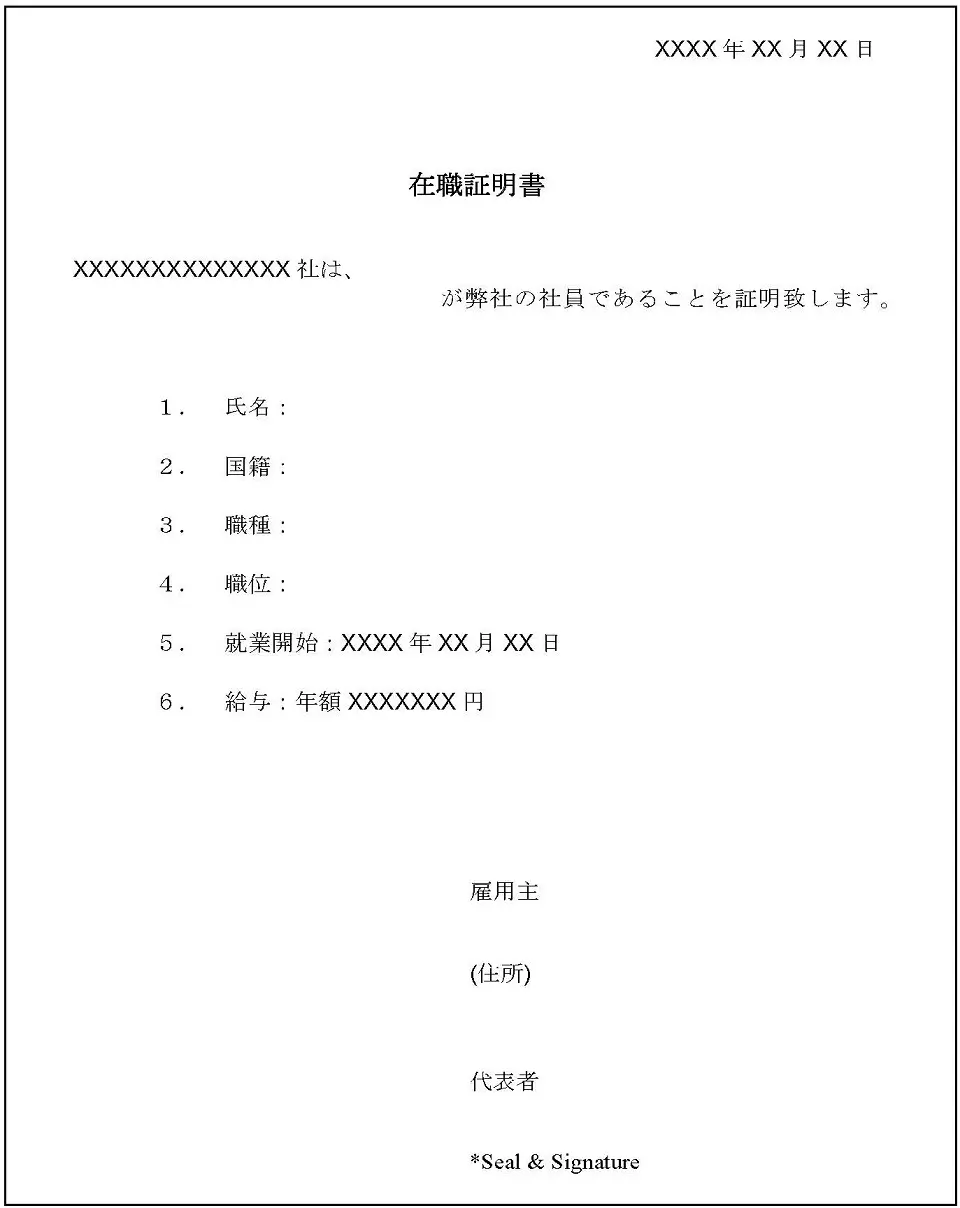

English Translation of the Employment Certificate Template
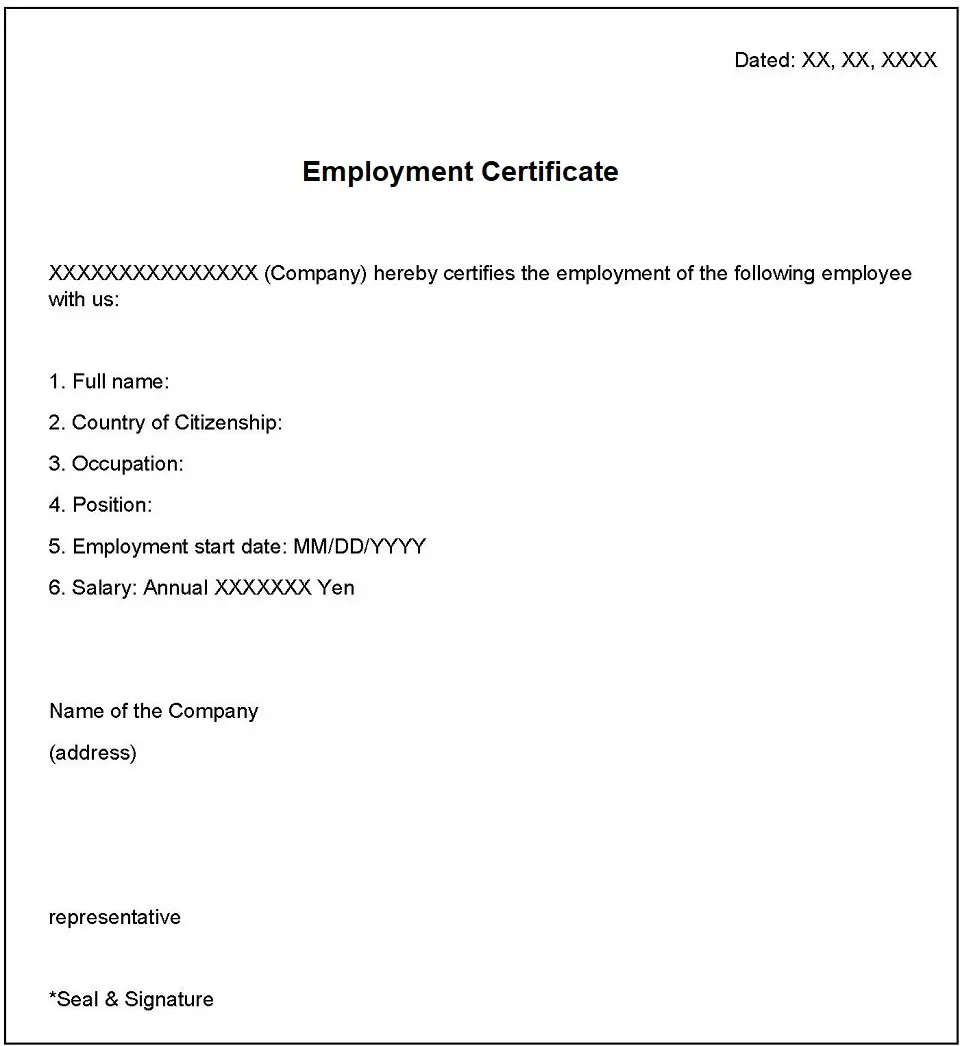

Concluding Note About Japanese Visa for Engineers
In this guide, we focused on the Japanese visa for software engineers under the categories of Engineer/Specialist in Humanities/International Services (“Engineering”) visa and the Japanese HSP visa.
However, these visa types apply to various other humanities and international services professions. Hence, please check the following infographic for the jobs and activities these two working Japanese visas cover.
Professions Covered by Humanities/International Relations/Engineer and HSP Visa – an Infographic
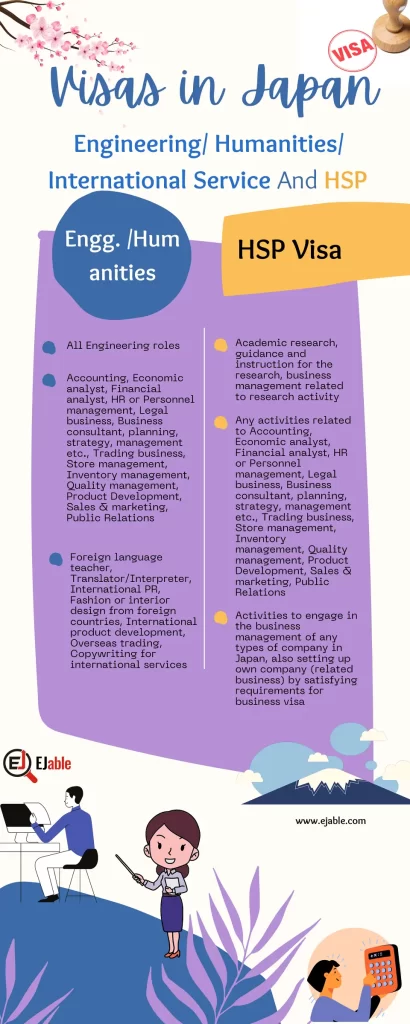

Japan is a lucrative destination for foreign software engineers because of a big demand-supply gap, and getting an engineer’s visa sponsorship is easier in Japan with the right skill set.
We hope this detailed step-by-step engineering visa guide will help engineers and visa-sponsoring companies apply for and secure Japan visas for their foreign software engineers smoothly.


A long-term ex-pat in Japan, Himanshu comes with an IT background in SAP consulting, IT Business Development, and then running the country operations of an IT consulting multinational. Himanshu is the co-founder and Managing Director of ReachExt K.K. and EJable.com. He is also an Advisory Board Member of a Silicon Valley AI/IoT startup.

